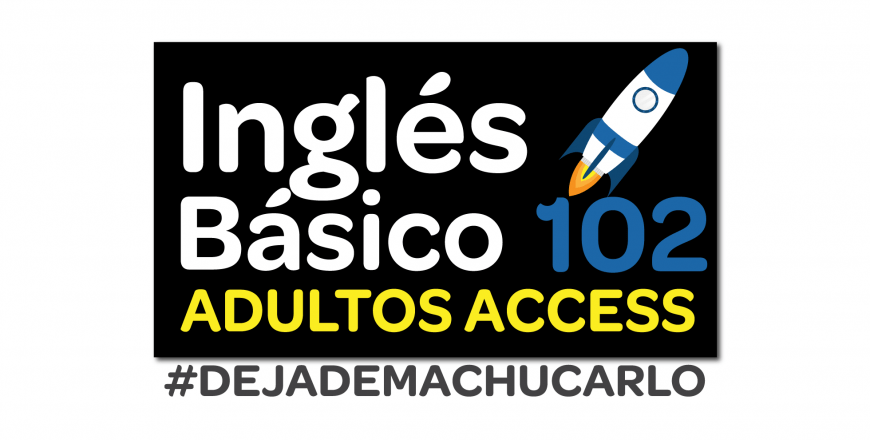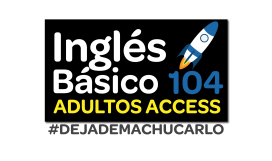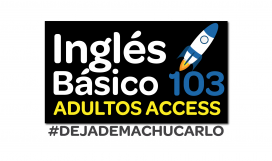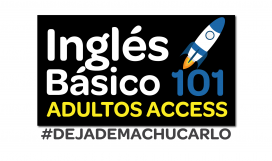Inglés Básico Adultos Access 102

El Inglés Básico Adultos Access 102 es un programa diseñado para mayores de 17 años. Es el nivel 2 de nuestro programa regular. Este combina los elementos fundamentales del idioma de forma puntual de modo que el estudiante sea capaz de utilizar el vocablo de inmediato. A partir de este momento, todo el contenido disponible será en inglés pues estaremos utilizando la metodología de aula invertida y el método comunicativo.
La metodología de aula invertida o Flipped classroom es la concepción de que el alumno puede obtener información en un tiempo y lugar que no requiere la presencia física del profesor. Se trata de un nuevo modelo pedagógico que ofrece un enfoque integral para incrementar el compromiso y la implicación del alumno en la enseñanza, haciendo que forme parte de su creación, permitiendo al profesor dar un tratamiento más individualizado. Por consiguiente, usted verá el contenido antes de su encuentro con el profesor.
Ventajas de esta metodología:
- Usted es el protagonista
- Uso de tecnología y plataformas web
- Consolida el conocimiento
- Favorece la diversidad en el aula
- Aprendizaje más profundo y perdurable en el tiempo
- Mejora el desarrollo de las competencias por el trabajo individual y colaborativo
Esto permite que los encuentros sean más enfocados en la parte oral, haciendo uso del método comunicativo o CLT, que es un enfoque en la enseñanza de idiomas donde se prioriza la interacción oral del lenguaje.
Bienvenido al mundo bilingüe!
Lesson 7A
These are the topics students are going to be able to learn at the end of lesson 7A. Including topics such as: how to describe a house and the common furniture found there.
In this lesson you will need to watch a video that teaches you the different rooms in a house. So, you are goin to learn their names and use.
In this activity, you will need to watch a video that will teach you the parts of the house and furniture vocabulary.
In this activity, you will need to watch a video of the rooms in a house and answer the questions within. It is to practice this vocabulary.
In this activity you will need to look for the parts of the house names on the grid.
In this activity you will need to drag the names to the correct box that shows that part/room of the house.
In this activity you will need to look for the furniture names in the word grid.
In this activity you will need to study the cards with house furniture and appliances vocabulary.
In this activity you will need to guess the names of the furniture and appliances shown on the pictures.
In this activity, you will need to watch a video that will teach you how to use the auxiliary verb 'Do' in the simple present tense.
In this activity you will need to complete the conversation with the correct form of the auxiliary verb 'do'' when needed.
In this activity you will need to answer a set of questions using the auxiliary verb 'do' based on what you see on a picture.
Lesson 7B
These are the objectives of Lesson 7B, which include topics such as: the use of 'there is' and 'there are' and the different types of houses there are.
In this activity you are going to need to watch a video that will teach you the use of 'there is' and 'there are'.
In this activity you are going to need to complete some sentences with 'there is' or 'there are' within an interactive video.
In this activity you are going to need to complete some sentences with 'there is' or 'there are' within an interactive video.
In this activity students have to fill the boxes with there is or there are when corresponding.
In this activity you will need to watch a video that will teach you how to describe a house or room using 'there is' and 'there are'.
In this activity you are going to need to complete the description of the rooms based on the pictures using there is and there are.
In this actity you need to study a bunch of cards with different types of houses and the definition of each one.
In this activity you are going to need to guess the names of the types of house from some pictures.
In this activity you are going to need to look for the words listed (types of houses vocabulary) in the grid.
Lesson 8A
These are the objectives of lesson 8A, which include topics such as: occupations and WH-questions in the simple present.
In this activity you are going to need to study the cards that contain workplaces and the jobs that take place there.
In this activity you are going to need to watch a video that will teach you some jobs and occupations names.
In this activity you are going to need to look for a list of occupation names in a grid.
In this activity you are going to need to read a few staments of people's occupations and say if the're true or false.
In this activity you are going to need to answer a set of questions choosing the correct WH-word to complete the questions.
In this activity you are going to need to drag the correct word or phrases to the correct boxes to complete the sentences.
Lesson 8B
These are the objectives of lesson 8B, which include topics such as: the correct placement of adjectives in a stament and how to read and listen for specific details.
In this activity you are going to need to watch a video that will teach you 2 different ways in which you can place an adjective correctly in a sentence.
In this activity you are going to need to unscramble a group of sentences to make complete statements or ideas.
In this lesson students will listen to a conversation and answer specific questions about the conversation.
In this activity you are going to need to guess the name of the professions by looking at a picture, then give your opinion about each of them.
In this exercise you will learn some specific information about some jobs/profession and will answer with the name of the job/profession.
In this exercise you will read about some strange and fun job description. Some of the words are in BOLD, so the student can look for them in the dictionary.
This a short quiz of lessons 8A and 8B to test the knowledge adquired throughout both lessons.
Lesson 9A
This is the description of this unit objectives and their uses.
In this exercise you will have to watch a video with a wide vocabulary on different foods and drinks, so you can learn and expand your vocabulary and speak more and recognize your favorite food.
In this activity you will have to watch a video to learn names and looks of different fruits and vegetables to expand your food vocabulary.
In this activity you will have to find the names of popular food options, and select them. That way you will improve your vocabulary.
In this exercise you will have to read the paragraph about someone's favorite food and then answer the true/false question below.
In this activity you should have to look at some pictures and read the info in the back, that way you will be able to learn more about different types of edibles.
In this exercise you will watch the video and listen to the conversation in it in order to answer following exercises.
In this exercise you will have to check the image and write down the name of the element in the pictures.
In this activity you will have to fill the blank spaces with names of the popular food types, that will help you to understand characteristics, preparations and origination of these foods.
In this exercise you will have to watch a video about grammatically correct uses of Some and Any.
In this exercise you will have to use what you learn from the unit to fill in the blanks with the correct use of Some/Any.
Lesson 9B
These are the objectives of lesson 9B, which include topics such as: how to use the adverbs of frequency and eating habits.
In this activity you will have to watch the grammar video of the adverbs of frequency, to learn the correct way of using them and place them.
In this exercise you will have to listen to the conversations and answer the specific questions below.
In this lesson you will have to watch the interactive video and answer the questions with the correct adverb of frequency.
In this lesson you will have to organize the sentences in the blank space, each sentence is structured with Adverbs of frequency.
In this activity the students will have to listen to the tips in the video about healthy eating habits and answer the questions below.
This is a simple quiz from unit 9 ( A and B). That way the student will be able to test their knowledge.
Lesson 10A
These are the objectives of lesson 10A, which include topic such as: Sports to play and watch, WH-questions in simple present and free time activities.
In this exercise you will have to check the pictures and read the information about the sport on the back, to learn about each sport.
In this activity you will learn to visually identify aspects and names of the different types of sports.
In this activity you will have to look for different sport names in the list, in order to identify and learn the sports vocabulary from this unit.
In this activity you will have to watch the video and listen to the conversation to answer the questions below.
In this activity you will have to watch the video and listen to the conversation to answer the questions below.
In this activity you will have to watch a video about the grammar of the WH questions in simple present, to use it in conversations.
In this activity you will have to watch a video about the grammar of the WH questions in simple present, to use it in conversations.
In this exercise you will have to use the WH questions to complete the questions checking the answers below.
In this activity you will have to organize the sentences in the correct order using WH questions in simple present.
Lesson 10B
These are the objectives of lesson 10B, which include topic such as: Discussing about skills, abilities and talents, using Can/Can't to ask and answer questions about skills, talents, abilities and more.
In this exercise you will learn the correct use of can, can't and cannot, to use it in your conversations.
In this lesson you will learn how to formulate questions using can, can't and cannot, to create questions with short answers.
In this exercise you will have to use can/can't to complete the corrrect questions and answers.
In this activity you will have to use can and/or can't to fill the spaces and complete the sentences.
In this activity you will learn some skills and abilities to ask and answer using can/can't in your future conversations while expand your vocabulary.
In this activity you will read a text and then answer the questions below, using can/can't as you need about the skills and abilities from the text.
Lesson 11A
These are this lesson objectives, that includes topics such as: Discussing future plans and special dates using ordinal numbers, month names, "going to" and more.
In this exercise you will have to watch the video and learn the use of "going to" to discuss future plans and actions.
In this activity you will have to watch the video and learn the differences in use of "Going to" and " I will" to discuss future plans.
In this activity you will complete the interactive video by watching it and answering the quiz in it.
In this exercise you will have to watch and interact with the video to answer the questions in it from the use of "Going to"
In this exercise you will have to watch the video and listen to the conversation in order to answer the questions below.
In this activity you will learn how to use ordinal numbers and dates to apply in the discussions about future plans.
In this activity you will have to fill in the blank spaces with the long ordinal name of the number displayed.
In this activity you will have to fill the blank spaces with the correct name of the month or the ordinal number for the date.
Lesson 11B
In this activity you will have to watch the video to learn the different holidays that we normally celebrate through the year.
In this activity you will have to read the texts for some holidays and answer the questions below.
In this activity you will have to learn to visually identify the different holidays looking at the pictures.
In this lesson you will learn how to make and discuss plans for holidays, future activities and celebrations.
In this activity you will have to drag and drop the answers to the WH questions about the holidays plans.
Lesson 12A
These are the unit 12A objectives, which includes topic such as: Parts of the body, Health problems and how to discuss them.
In this lesson you will have to watch the video to learn how to identify the body parts.
In this activity you will have to look at the cards( front and back) to learn how to identify the parts of the body.
In this lesson you will have to look at the flashcards and complete them with the name of the body parts.
In this activity you will have to speak and pronounce the name of the body parts (needs microphone and google chrome browser).
In this exercise you will have to read and organize the words (names of parts of the body) in the correct order in the blank space.
In this activity you will have to watch the video and listen to the conversation to learn how to express and discuss about feeling sick.
In this activity you will have to watch the video and listen to the conversation to learn how to express and discuss feeling sick in a conversation.
In this activity you will have to watch the video and listen to the conversation to learn how to express and discuss about feeling sick.
In this activity you will have to look and read the cards (front and back) to learn about common health problems and sickness.
In this activity you will have to look at the image and name the health issue below with what you have learned from the vocabulary cards.
In this activity you will have to complete the sentences with the health problems that you have learned from the vocabulary.
Lesson 12B
These are the objectives for Lesson 12B, that include topic such as: Common remedies for health problems, Imperative, using imperative for health conversations and more.
In this lesson you will learn how to give advice in English, and use that in conversations to give advice about health problems.
In this activity you will have to listen to the conversation at the doctor's office and answer the questions below.
In this lesson you will learn about the grammatically correct way to use imperatives in English. That way you will learn how to give advice and orders.
In this lesson you will learn about the grammatically correct way to use imperatives in English. To learn how to give advice and orders.
In this activity you will have to watch the video and listen to the advice of the doctor, to answer the questions below.
In this exercise you will have to read the cards front and back to learn about home remedies and add them to your vocabulary.
In this exercise you will look at the picture and answer the question below with the correct home remedy.
In this activity you will have to answer with the correct health advice using imperative.
Lesson 13A
This are the objectives of lesson 13A, where you will learn about things such as: Places to go, how to use prepositions of place and how to apply both in conversation.
In this activity you will have to watch the video and learn about common places to buy/do stuff on a regular basis.
In this activity you will have to read the cards front and back, to learn about common places that people go to on a daily basis.
In this activity you will have to look at the cards and answer the question below.
In this activity you will have to fill the spaces with the correct place that you need to go, using the vocabulary
In this activity you will have to say the word on the screen to learn how to pronounce them and add them to your conversations.
In this activity you will have to watch the video to understand how to use prepositions of place, and add them to your conversation skills.
In this activity you will have to watch the video to understand how to use prepositions of place, and add them to your conversation skills.
In this lesson you will have to answer the questions using the prepositions of place in the picture.
In this activity you will have to read the text and click on all the Prepositions of place that you see in the text.
Lesson 13B
In this activity you will watch the video to learn about the various prepositions that we use in English to give and ask for directions.
In this activity you will have to watch the videos to learn about the vocabulary we normally use in English to give and receive directions.
In this activity you will watch a video about asking and giving direction to tourist places, such as museums and beaches.
In this lesson you will have to read both sides of the cards to learn about some popular tourists places around the world.
In this lesson you will have to check at the pictures of tourist places, and answer the questions below correctly.
In this activity you will have to click on any preposition of direction that you find in all the conversations, to understand how to use them properly.
This is a short quiz from units 13 A and B, so the students will prove what they have learned.




